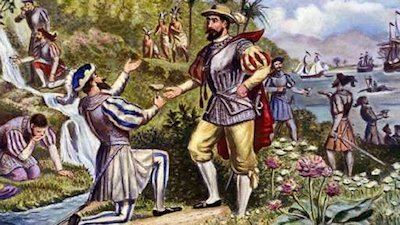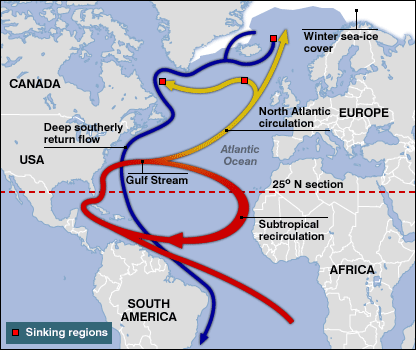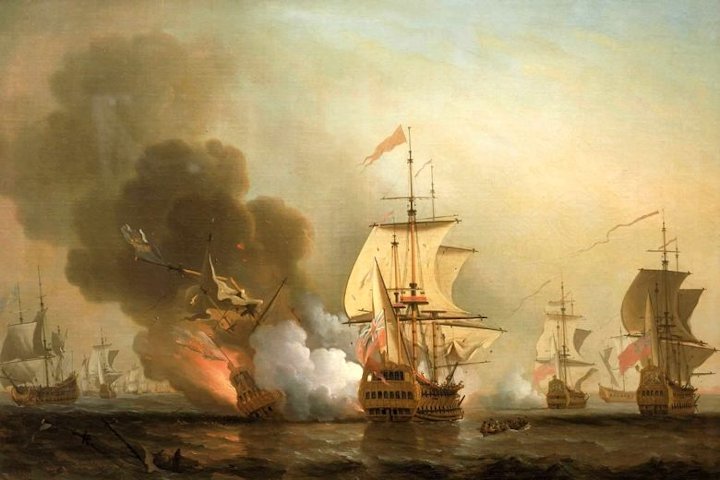It is a fascinating thing how history morphs into legend. The sands of time shifting back and forth across a topic tend to weather it down, polish it up and make it sparkle. Like stones in a rock tumbler, the end result barely resembles the raw material that originally went in.
Early American history is like that. Quests for gold become searches for Fountains of Youth. And piratical intentions become glossed over and repackaged as lofty goals of colonization. In today’s world, to understand the why of a thing we know to simply follow the money trail – as the saying goes. The 16th century was no different. We are but the next chapter of the same book.
Supporter Spotlight
During the Age of Exploration, to follow the money trail one had only to seek out a great current in the ocean of unimaginable proportions. It wielded the power to control the weather and shape the lives and cultures that fringed both sides of the Atlantic. It was a current on which empires would rise and fall. Fortunes would be made and lives would be lost.
When it comes to the story of the Americas, of the meteoric rise of the Spanish empire, of the founding of Roanoke, and the birthing pains of our own nation, we find that this so called money trail drifted like so many toy ships upon the back of the Gulf Stream and our history is inextricable from it.
The Arrival of the Spanish

Star Date: 1513. A Spanish conquistador by the name of Juan Ponce de Leon was setting sail from Puerto Rico where he had resided as governor until a falling out with Christopher Columbus’s son lost him his title. Now, with a new patent from the Spanish crown in hand to head north in search of gold and glory, Ponce de Leon’s expedition plied the coralline blue waters of the north Caribbean toward an unknown world.
The results of his voyage would add new lands to the empire to be named La Florida for the Spanish Pascua Florida, or “Feast of Flowers.” Although history has remembered this conquistador as the Spanish fool swatting mosquitoes and stumbling blindly through the swamps of Florida in search of the mythical Fountain of Youth, such legends are historically ungrounded and were created only after his death. Like all other expeditions of the day, this one had but two purposes: discover new lands and bring home gold to recoup the costs.
Although he didn’t discover the Fountain of Youth – he probably wasn’t even looking for it – Ponce de Leon did stumble upon something that would get his name into the history books. In his journal, dated April 22, 1513, Ponce de Leon wrote that his ships had entered “a current such that, although they had great wind, they could not proceed forward, but backward and it seems that they were proceeding well; at the end of it was known that the current was more powerful than the wind.”
Supporter Spotlight
In all of its awkwardness, this is the first written acknowledgment of the Gulf Stream in history. Yet, despite the magnitude of this discovery, neither Ponce de Leon nor the Spanish Crown paid heed to it. Back in Spain, the only thing that came of this expedition was the acknowledgment that Ponce de Leon had failed to find gold.
North Atlantic Gyre

Pumping tropical 80 degree waters past our coast year-around, the Gulf Stream is one part of a four-part system of currents swirling in a clockwise fashion around the Atlantic Ocean. This vortex of currents is what we call the North Atlantic Gyre. Made up of the Gulf Stream in the west, the North Atlantic Current in the north, the Canary in the east and Equatorial in the south, this gyre is a never ending cyclone of water drifting round and round. It is itself part of even greater systems, like the thermohaline circulation, of complexities that we’ll save for another day.
You really can’t live on the coast of North Carolina and not know something about the Gulf Stream. It’s an important part of life here. From the weather we enjoy, the fish that we eat, to the history buried beneath the sand and limestone of our coastal plain, the Gulf Stream is a river of life gently embracing our coastline like a romantic lover, before casting off toward blue horizons at Cape Hatteras.
In the early part of the 16th century however, when charts still warned of sea monsters, and scholars debated whether or not the ocean boiled at the tropics, knowledge of such currents was in its infancy. For Ponce de Leon and all other would be adventurers risking life and limb for gold and glory, the region of the Gulf Stream, and what would become North Carolina for that matter, was still oceanum incognitus.
The true significance of this discovery would remain unrealized until Anton de Alaminos, the navigator of Ponce de Leon’s Florida expedition, was outfitted with a ship of his own by Cortez, the butcher of Mexico, some six years later with orders to transport a cargo of treasure back to Spain. The Spanish empire in the New World had been a financial loss up to this point. Huge sums of money had been poured into exploration and colonizing with little returns, save for the sugar plantations established during Columbus’ second voyage. Cortez would change all of that when he landed on the coast of present-day Mexico and stumbled upon the Aztec capital of Tenochtitlan. The Aztecs were fabulously wealthy, adorning both their bodies and city in gold. But instead of repelling Cortez when he was found trespassing, the Aztecs welcomed him and his men into the capital city with the mistaken assumption that they were the return of Quetzalcoatl as prophecy had foretold. In response, Cortez acted in typical psychopathic conquistador fashion and set about slaughtering every man, woman and child in the city.
Momentous Change

With this moment in history, everything changed for the empire. Spain found itself in possession of mountains of New World gold. Yet before a single ounce could translate into real wealth, it had to traverse several thousand miles of open ocean back to Spain at a time when up to half of all ships attempting a transoceanic voyage were lost at sea.
Anton de Alaminos was hand picked by Cortez for the job because of his well-known exploits as a navigator. He had shown an ability to read the waters in novel ways throughout both the Gulf and the Caribbean. Who better to captain the very first Spanish treasure fleet to set sail from Nuevo Espana?
Alaminos, also a veteran of Columbus’s final voyage, remembered well the impossible power of the great current’s pull northward through the Florida Straits. He had already sailed south down the coast of Europe and Africa along the Canary Current. He had experienced firsthand the westward pull of the North Equatorial Current that Columbus had discovered. And so instead of simply tacking his way back east toward Europe, battling trade winds, risking his ships being becalmed in the Sargasso Sea that makes up the middle of the Atlantic and languishing for weeks on end as they waited for a breeze, he did the unthinkable and sailed north. This was a gamble of course. One that placed both his life and the crown’s gold in the hands of the unknown, risking everything on the idea that this new current he helped discover would prove to somehow connect with the Canary some several thousand miles to the east. Upon reaching the vicinity of what is now Cape Hatteras, one can only imagine the relief that swept over the entire crew as their current turned east.
Digging up the exact amount of time that it took Alaminos to swing Cortez’s gold back over to Spain on the Gulf Stream is like modern-day marine archaeologists trying to find the shipwrecked galleon El Salvador off the coast of Cape Lookout. But the hard facts we know of the Stream today do allow for certain assumptions to be made.
By the time the Gulf Stream reaches Cape Hatteras, that point in which it breaks free of the shackles imposed by continental land masses and heads in a more easterly direction, some 150 million cubic meters of water is jetting past the cape every second. This translates to an increase in speed of between two and four miles an hour for a ship caught within the tropical embrace of the current. Columbus’ return voyage was set on a direct heading back to Spain and took a solid three months after departing Hispaniola on Jan. 16, 1493. With the aid of the Gulf Stream, that voyage could have been reduced to as little as one month.

Alaminos voyage set a precedent. By working with the physical properties of the Atlantic and its northern gyre of currents, a modicum of efficiency and predictably could be applied to a notoriously unpredictable venture. Well, that, and it was just a whole lot faster.
For the next 200 years, every one of the Spain’s legendary treasure fleet, Flotas de Indias, would retrace Anton de Alaminos route through the Florida Straits north past Cape Canaveral, Cape Fear, Cape Lookout and to the diamond shoals of Cape Hatteras from which both Gulf Stream and galleon peeled away from North America toward the open ocean and, eventually, Europe.
The Aztec gold floating along the Gulf Stream that Alaminos delivered to Charles V of Spain was soon followed up with Pissarro’s theft of the Incan empire in Peru. But although every pirate story worth its salt would have you to believe the treasures of the New World left in the form of gold doubloons, it was in fact silver from the great mines of Potosi, which became the global currency for hundreds of years to come in the form of Spanish silver pieces of eight, that truly catapulted Spain into the realm of world superpower and placed a target on the hull of every leaky boat flying the Spanish flag.
England’s Perilous Slide

For a place like England, a third-rate nation on the fringe of Europe, it was difficult to sit idly by watching as Spain’s wealth and power soared. For decades, the silver and gold filled Spain’s coffers while the island nation’s power slowly dwindled. Yet, sit by and watch is exactly what the English did.
Wars of conquest raged across the European continent. Alliances were formed, broken and amended. But not until a man by the name of Martin Luther wrote down his Ninety-Five Theses would England unknowingly find itself on a trajectory at odds with Spain and on the verge of its own brand of empire entangled within the Gulf Stream.
Thanks to his love affair with one Anne Boleyn, King Henry VIII of England denounced the authority of the pope. Claiming that he spoke for God in his country, Henry annulled his legal marriage with Catherine of Aragon to marry whatever girl he happened to fancy at the time.
This break with the Catholic Church would lock Spain and England into a tumultuous relationship that, as any high-schooler will tell you, can be confusing to keep up with. We can skip over all the wives, the various children, diplomatic marriages, the parts about Bloody Mary, how England became ruled by Spain for a short while, and get to the good stuff – that part of the story that would spill off of the European Continent and into the Atlantic Ocean, where it would come washing up upon the shores of Roanoke.
The Pirate Queen
Queen Elizabeth I, daughter of Henry VIII and Anne Boleyn, was left with a shell of a country when she assumed the crown in 1558 at the age of 25. The country was broke, internationally powerless, with a continent of enemies across the English Channel and no real navy to speak of — a bad position for an island nation. Elizabeth turned to a council of trusted nobles who would suggest she seek out fame and fortune for England much the way that Spain had done so many decades before – by stealing it.
Since men first set sails to the wind, piracy became an occupation of choice for the lower castes that knew their way around the ropes. And in Elizabethan England, privateering became one of the only means of social upward mobility for those of a common birth. History would come to know Queen Elizabeth I as many things, but it is the name that she was given by both Spain and the Catholic Church that is most relevant here: la Reina Piratas – the Pirate Queen.

With immense fortunes floating across the ocean each year just asking to be preyed upon, Queen Elizabeth’s Lord Admiral set about signing letters of marque for any captain who could muster up a ship to sail. Though acts of privateering did occur along the Canary Current off the coast of Europe, the real action would take place closer to the source in the original wild west of the Caribbean and outflowing Gulf Stream. These Elizabethan privateers would come to be known as the queen’s Sea Dogs. Francis Drake, John Hawkins, Humphrey Gilbert, and Walter Raleigh topped the list. The ranks of Elizabeth’s privateer navy grew with the escalating tensions between Spain and England.
We are not sure who suggested it first – Richard Hakluyt, Gilbert or Raleigh. But we do know that all three of these influential men in the court of Elizabeth lobbied for the creation of a fort along the coast of what would become North Carolina for the express purpose of launching raids against the Spanish treasure fleets. Such a location was far enough away from Florida so as not to be attacked by land, yet it was situated where the Gulf Stream came the closest to land after leaving the Spanish-controlled Florida Straits.
Queen Elizabeth, for her part, had already begun to consider the possibility of expanding her reach into the Americas, much as Spain had done so many decades before. All empires start with the twinkle of new lands in the eyes of would be emperors. As Spain already learned, the business of colonizing is an expensive one. Using the new the colony on the edge of the Gulf Stream as a base to launch for raids against the Spanish was exactly the bait that was needed to persuade the wealthy merchants of London to help back such a thing.
Up until the 1580s, the hostilities between Spain and England were more of a cold war than a hot one. Ships were being attacked, and tempers flared, but it was not until the early part of that decade that the so called 80-Years War would devolve into full scale warfare. It’s not a coincidence that Walter Raleigh was given a patent by the crown of England for exploration and the establishment of a colony and military fort in 1584 – the time when the war with Spain was escalating.
Roanoke Expeditions
Everything about the Roanoke Expeditions came to look like privateering. On Grenville’s first trip in 1585, he scribbled into the log book on Aug. 31 that he “tooke a Spanish ship of 300. Tunne richly loaden.” His following voyage in 1586 was no different. Sir Richard Grenville had long been one of Elizabeth’s famed Sea Dogs. Prior to the Roanoke Expeditions, in 1575 Grenville had received a patent from the Privy Council to become the first Englishman to round Cape Horn so as to attack the Spanish along the Pacific Coast of the Americas and to then continue westward to the Cape of Good Hope and back to England. This is worth noting, as it means that the first Englishman to sail around the world was to do so on a privateering mission. The patent was rescinded during diplomatic negotiations with Spain’s King Phillip II, but was then given to Sir Francis Drake three years later who became the first Englishman to circumnavigate the globe, in the process capturing one of the greatest fortunes ever taken on the high seas by a privateer.
When Ralph Lane and his men, whom Grenville had left on Roanoke to build the new fort, were rescued in 1586, it was non other than Sir Francis Drake who plucked them from the island. The most notorious of all Elizabethan privateers, Drake had completed his circumnavigation of the globe six years earlier, laying siege to the entire Manila treasure fleet in the Pacific for good measure. When he stopped at the Roanoke colony, Drake was on his way back to England after his famous Great Expedition. He controlled 21 ships and 1,800 men, attacking villages on the coast of Spain; plundering Santiago in the Cape Verde Islands; sacking the port of Santa Domingo; capturing the city of Cartagena de Indias in Columbia; raiding and burning down the Spanish fort at St. Augustine; and still making time to swing by Roanoke to check in on Lane. It should be noted that his list of exploits roughly follows the route of currents that make the grye.

As for the fabled Lost Colony itself, technically speaking, the Roanoke Colony was not actually supposed to be the Roanoke Colony. It was intended to be the Chesapeake Bay Colony and Roanoke was to only be a fort. Simon Fernandez is largely to be blamed for this. He had been chosen to pilot John White’s colonists to the Chesapeake and it was his fateful decision to kick his passengers off the ship at Roanoke instead of sailing north. Fernandez was Portuguese. He had sailed for the Spanish for many years before thumbing his nose at the emperor and slipping away into the murky waters of piracy.
Naturally, Fernandez partook in what seems to be the obligatory privateering of all expeditions heading to Roanoke, capturing several ships along the way. Once at Roanoke, his excuse for dumping the colonists in the wrong place was simply that it was too late in the summer for him to continue north. It was July. The Spanish treasure fleets sailed at the beginning of August. The Chesapeake was too far north of the Gulf Stream, and the timing was too close. For Fernandez, it was either sail south now to try and intercept Spanish ships, or sail north to the Chesapeake with the colonists and miss out on the Spanish flotilla all together. Once a pirate, always a pirate.
The story goes on. And quite conspicuously, each character that makes an appearance in this story of Roanoke, save for the colonists themselves, were all engaged in the occupation of privateering for England. From the queen who sanctioned it, the merchants who backed it, the men who plotted it and the captains who piloted it, the purpose of Roanoke was to lighten Spain of its burden of wealth. And it was the Gulf Stream, the great river in the ocean that runs through the heart of this story, and England’s first attempts at scratching out a place of its own on foreign shores.
Would England have stretched its fledgling wings of empire across the Atlantic if it had not been for the Gulf Stream? Most likely. It was the fashionable thing to do at the time. Yet, if it had not been for the Pirate Queen and her Sea Dogs, the Lost Colony, that mysterious connection that North Carolina holds to the Age of Exploration, would have looked a whole lot like Jamestown, which was established after a peace treaty with Spain had been signed. Or more likely, it never would have existed in North Carolina to begin with, given the treacherous nature of what the late historian David Stick coined the Graveyard of the Atlantic – with hull-splintering shoals and no deep-water port to speak of.
The Spanish Empire was built, in part, on the Gulf Stream. With the realization of its power to propel ships departing the Caribbean to the shores of Europe, it became a conveyor belt ushering wealth stripped from the Western Hemisphere. As for the rest of Europe, ships hailing from every country with a port came to line up along the edges of this current like so many highwaymen waiting for the chance to steal a slice of the pie. England was no different. And Roanoke was the lovechild of such piratical intentions.







